Nautiloïds
1: Presentation
Nautiloids are a subclass of Cephalopod Molluscs (from the Greek Képhalê meaning head, and podós meaning feet). They are tetrabranchial animals - that is, equipped with 4 gills - whose body is entirely protected by a shell. They are distinguished from dibranchial Cephalopods (equipped with 2 gills) which have an internal shell or no shell. Among the dibranchials, we distinguish the Decapoda (cuttlefish, squid) and the Octopoda (octopus or octopus). Nautiloids are pelagic animals (living in open water) and exclusively marine. No species of Cephalopod is known from river or lake environments, either in the fossil record or today. The only exception is the shortfin squid (Lolliguncula brevis), known from the Chesapeake Bay on the east coast of the United States, which tolerates slightly brackish water. They have been known since the Late Cambrian period. The oldest of these fossils have been found in the Fengshan Formation in northeastern China, dated to about 500 million years ago.
Unlike their close cousins, the ammonites, the nautiloids survived the Cretaceous/Paleogene crisis, which wiped out three-quarters of terrestrial flora and fauna 65 million years ago and led to the extinction of the dinosaurs. It is assumed that the nautiloids survived this crisis unscathed because they were opportunists with a diverse diet and even scavengers. In contrast, the ammonites, which were much more specialized, could not adapt to the sudden lack of food and became extinct.
The species and genera of fossil nautiloids are very numerous and varied. Currently, only the genera Nautilus and Allonautilus remain, which include only 6 species still existing today: Nautilus belauensis, Nautilus macromphalus, Nautilus pompilius and Nautilus stenomphalus for the first genus, and Allonautilus perforatus and Allonautilus scrobiculatus for the second. They only appeared recently during the Quaternary era.
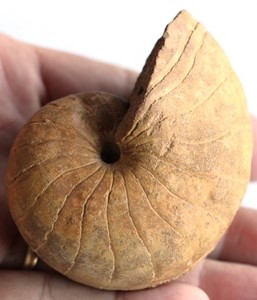
Two views of Cretaceous Anglonautilus. Note the ribs on the belly.

2: Evolution and morphology
The morphology of nautiloids has changed very little since their appearance in the Late Cambrian period 500 million years ago. They are closer to their Paleozoic ancestors than their modern cousins. Extant species are generally found at great depths, around several hundred meters, but nautiloid fossils are found in all types of marine environments. Approximately 2,500 species have been recorded from all ages and periods.
Nautiloids are the only living cephalopods to possess an external shell protecting their entire body. This shell is planispiral in shape, meaning it is coiled in a spiral along a single plane, for modern species as well as for the vast majority of fossil species. It is composed of numerous chambers, separated by partitions, which form as they grow. The animal occupies only the last chamber (called the living chamber), which is the largest, while the others contain a mixture of gas and water that the nautiloid can fill or empty to varying degrees to ascend or descend. A siphon runs through all the partitions to regulate the filling of the chambers. The position of the siphon can be an aid in species discrimination.
The shape of the partitions (or sutures) varies from straight to sinuous but remains very simple, similar to those of their close cousins, the primary ammonoids (order Goniatitida). In contrast, the Jurassic and Cretaceous ammonoids (order Ammonitida) developed sutures that are sometimes very complex. The shape of the suture lines is a key to species identification, both in ammonoids and nautiloids. In the fossil record, planispiral forms can vary. They vary from involute to evolute, that is to say that the external whorls more or less cover the internal whorls. The umbilicus (the set of internal whorls) is then more or less apparent, or even completely covered by the external whorls in very involute forms. Among the simple planispiral forms, we find for example the famous and prolific Cenoceras of the Upper Triassic to the Middle Jurassic which will give rise to the family of Nautilidae (whose descendants are our current Nautili), or the Anglonautilus of the Cretaceous. You will find examples of these two fossil genera for sale on our site.
In some fossil species, the shell is so evolute that the whorls are no longer joined together, as in the genera Ptenoceras or certain Gyroceras of the Devonian, or the Rineceras of the Carboniferous. We then speak of the Gyrocone or Gyroceracone form, but these remain rare.
More frequently, in other species, the whorls remain joined but the navel is not "closed", we then note the presence of a hole in the heart of the Nautiloid. We can cite for example the genus Syringoceras from the Triassic, but also Temnocheilus, Hemiliroceras or Metacoceras from the Permian of which you will find beautiful fossil examples for sale on our site.
Regarding the primitive Nautiloids, the widespread forms varied from straight to more or less curved. We speak of Orthocones for the former and of Cyrtocones for the latter. We distinguish the more elongated morphs, called longiconic, and the squat morphs, called breviconic. The shells curved until reaching a complete turn are the Gyrocone forms we discussed above.
The largest species of Orthocones known from the Ordovician reached spectacular sizes. The genus Endoceras is known from specimens of the order of 2 to 3 meters. The genus Cameroceras is even estimated at more than 10 meters.
In the Cyrtocones, the sizes were much more modest. We can cite the Pleuronococeras of the Devonian or the Cyrtoceras which evolved from the Middle Ordovician to the Middle Devonian.
Some rare genera have developed very particular morphs. The Lorieroceras of the Lower Devonian or the Pakrioceras of the Middle Ordovician for example have a form called Torticone, that is to say that the coiling does not occur on a single plane, but that the shell also develops in height (like a snail), and that the turns are not joined unlike the Turriliticon forms known in certain Ammonites of the Cretaceous, like the Turrilites or of the Triassic like the Cochloceras. The genus Lituites from the Ordovician is well known to fossil collectors; they are frequently found for sale. The shell is planispiral in shape but is extended by a long, even very long, shaft that contains the living chamber. This can even be larger than the shaft itself. The genus Lituites gave its name to its very particular Lituiticone shape.
The vast majority of Nautiloids have a simple, unornamented planispiral shape, but some species still stand out. Cooperoceras texanum from the Lower Permian, for example, is characterized by an unclosed umbilicus, but above all by two rows of long, curved points running along each side of the belly. Solenochilus springeri from the Upper Carboniferous or Acanthonautilus cornutus from the Permian have two enormous, protruding spines perpendicular to the shell's coiling plane, and located at the level of the living chamber. Nautiloids occupied a very important place within the marine fauna, from the Ordovician until the Devonian where they began to decline, perhaps due to competition with ammonoids and coleoids (belemnites ...). The diversity of nautiloid species continued to decrease during the Carboniferous and Permian but without disappearing.
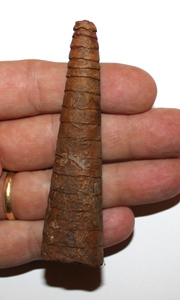
Orthocone nautiloid (right)
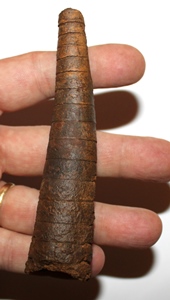
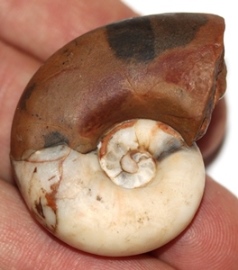
Syringonautilus du Trias inférieur
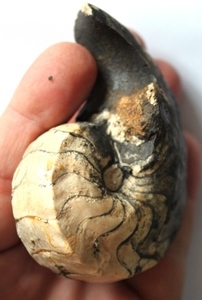
Cosmonautilus dilleri du Trias sup.
3: Some fossil nautiloids
Nautiloids were scavengers and opportunistic predators with powerful beaks that allowed them to eat crustaceans and shellfish, for example. These beaks (called "Rhyncholites") are sometimes found fossilized in rocks dating back to the Permian period, the oldest of which are known. In reality, a Nautiloid beak is made up of two parts: the Rhyncholiths itself, which corresponds to the upper part, and the Conchorhynchus, which corresponds to the lower part.
During the Ordovician period, Orthoceras were large predators at the top of the food chain; they are often found in large quantities on plaques with numerous specimens. Very often, these Orthoceras are polished for a simple question of aesthetics, but they then lose all their natural characteristics. Many Cyrtoceras coexisted with them.
During the Silurian, Peismoceras had developed a somewhat unusual morph: the coiling was not entirely planispiral. The outer whorls had a normal evolute coiling, but the inner whorls were detached from the outer whorls. In some specimens, the umbilicus protruded from the coiling plane of the phragmocone. They had a shell decorated with fine, regular ribs. Many orthocone and cyrtocone nautiloids of different genera still populated the Silurian seas.
During the Devonian, the vast majority of the nautiloid fauna was also composed of orthocones and cyrtocones. Among these, the genera Spyroceras, Cyrtoceras, Bactrites, and Isorthoceras are among the best known and most frequently found. A few gyrocones also developed during this period. Examples include the genera Trochoceras and Ptenoceras. Much rarer, Centroceras and Pleuroncoceras are small planispiral nautiloids with an unclosed umbilicus. You will find some examples of these fossils for sale on our site.
By the Carboniferous period, nautiloids had already declined significantly, probably due to the appearance of ammonoids with which they were in competition. The genera Rayonnoceras, Spyroceras, Cycloceras and Michelinoceras were among the most widespread orthocones. Among the planispiral forms, we can mention the genera Discitoceras, Solenocheilus and Stroboceras, which are still quite rare.
In the Permian, numerous genera of planispiral nautiloids, many of which have an unclosed umbilicus, appeared. Metacoceras, Hemiliroceras, Millkoninckioceras, Domatoceras, Epidomatoceras, Pararhyphaeroceras, and Temnocheilus, for example, are just a few examples. Liroceras have a closed umbilicus. A few genera of Orthocones and Cyrtocones, such as Dolorthoceras, Dentoceras, Mariceras, and Scyphoceras, are also noteworthy. They are mainly found in the Permian deposits of Kazakhstan and Timor. Many specimens of these Nautiloids are for sale on our site. The famous and very rare Cooperoceras texanum mentioned above, with their two rows of long, curved points running along each side of the belly, are particularly remarkable.
During the Triassic, the first period of the Secondary Era, numerous new genera appeared. Nautiloids survived the great extinction at the end of the Permian, which led to the disappearance of 95% of marine species and 70% of terrestrial species. The modern Nautilida family is directly descended from the Syringonautilidae of the Upper Triassic.
Among the diversity of Nautiloids existing at this time, we can cite a few genera that are quite well known to fossil enthusiasts. The Germanonautilus from the Upper Muschelkalk (Middle Triassic) have relatively flat sides and a more or less square belly. They reach sizes of around 20 centimeters. The rarer species Germanonautilus suevicus is characterized by a belly lined with tubercles and a size that can reach 40 centimeters. In Timor, the Triassic is particularly well represented, but the vast majority of Nautiloids are found in the Upper Triassic layers. A few genera are particularly present. Cosmonautilus and Proclydonautilus, for example, are very involute and have a very square belly. They can reach 30 centimeters. Depending on the species, the sides are more or less wide and flat. You can find many examples of Triassic Nautiloids for sale on our site.
In the Jurassic, the Orthocones disappeared. They became extinct at the end of the Triassic, although one genus is apparently recorded in the Cretaceous. All forms of Nautiloids are now planispiral and the vast majority of their shells are devoid of ornamentation. Only a few species may have slight costulation or tuberculation. By far the most widespread genus is Cenoceras,although it is no longer known after the Middle Jurassic. The related species vary from involute to evolute, the shapes go from very flat to very globular. The Eutrephoceras succeed the Cenoceras in the Upper Jurassic and are known until the Miocene. In France, numerous specimens of Cenoceras are known from the famous Belmont d'Azergues deposit. The genus Paracenoceras is also known from the Upper Jurassic. It is recognizable by its generally very square belly.
During the Cretaceous period, the diversity of Nautiloids is increasingly restricted. A few genera still survive among the numerous Ammonites that colonized the seas. We can cite the Pseudocenoceras, the Anglonautilus, which are quite large and have ridges running down each side of the belly, the Cymatoceras with their fine, tight costulation, or the Eutrephoceras mentioned above, which are globular and small. Regarding the entire Tertiary (or Cenozoic) era, very few Nautiloids are still present.
Although they survived the Cretaceous/Paleogene mass extinction, unlike the Ammonites, which became extinct, very few remain. One genus, however, deserves to be mentioned: the Aturia. They are small and very flat and are easily recognizable by their particular sutures. A large saddle covering almost the entire flank is followed by a very narrow lobe that gives the impression that a continuous line runs parallel to the outer edge of the shell. These Nautiloids are rare but particularly aesthetic, especially when calcified.
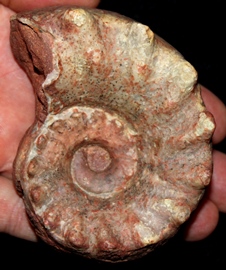
Temnocheilus du permien
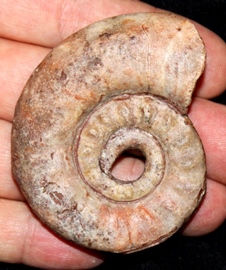
Rhyphaeoceras du permien

Permian Epidomatoceras
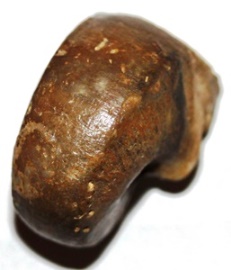
2 views of Somalinautilus from the Bathonian of Nièvre.
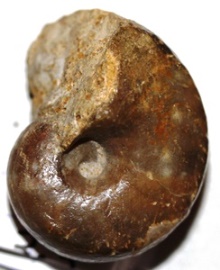
4. Conclusion
In the fossil record, Nautiloids evolved to quickly reach the top of the food chain and diversify their morphs, sometimes developing extreme ornamentation, but these were never as varied as those of their cousins, the Ammonites. From the Late Cambrian to the present day, they have evolved little. They have survived all the major crises of evolution thanks to their adaptability. Although their diversity greatly diminished from the Carboniferous period onwards, probably due to the appearance of Ammonoids, they have nevertheless always continued their evolution. Although the forms, genera, and species are much less diverse than those of Ammonites, they are still particularly appreciated by collectors and fossil enthusiasts.
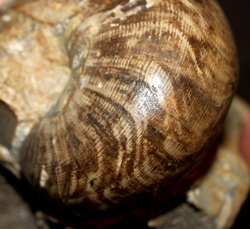
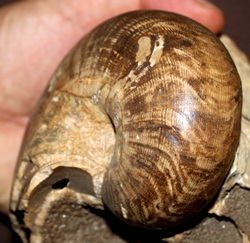
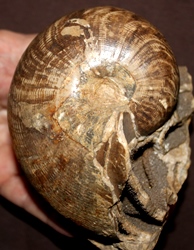
3 views of a Jurassic Cenoceras. Note the beautiful preservation of the striations present on the shell.














